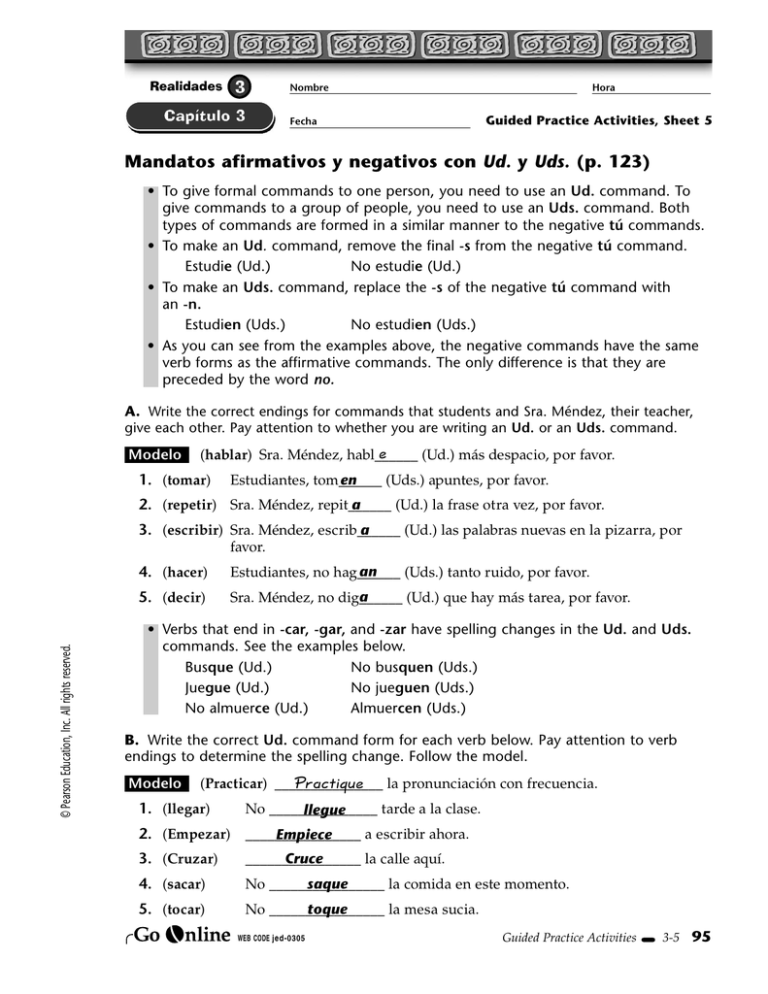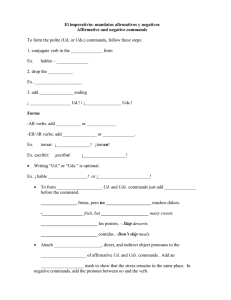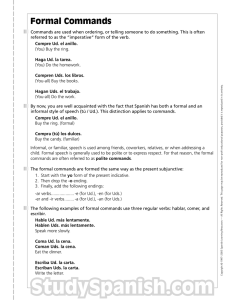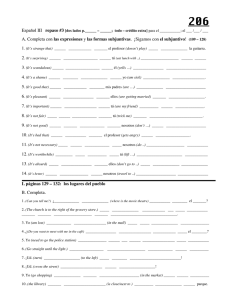Mandatos afirmativos y negativos con Ud. y Uds. (p
Anuncio

Realidades Nombre Fecha Hora Guided Practice Activities, Sheet 5 Mandatos afirmativos y negativos con Ud. y Uds. (p. 123) • To give formal commands to one person, you need to use an Ud. command. To give commands to a group of people, you need to use an Uds. command. Both types of commands are formed in a similar manner to the negative tú commands. • To make an Ud. command, remove the final -s from the negative tú command. Estudie (Ud.) No estudie (Ud.) • To make an Uds. command, replace the -s of the negative tú command with an -n. Estudien (Uds.) No estudien (Uds.) • As you can see from the examples above, the negative commands have the same verb forms as the affirmative commands. The only difference is that they are preceded by the word no. A. Write the correct endings for commands that students and Sra. Méndez, their teacher, give each other. Pay attention to whether you are writing an Ud. or an Uds. command. Modelo: e (hablar) Sra. Méndez, habl______ (Ud.) más despacio, por favor. 1. (tomar) en Estudiantes, tom______ (Uds.) apuntes, por favor. a 2. (repetir) Sra. Méndez, repit______ (Ud.) la frase otra vez, por favor. © Pearson Education, Inc. All rights reserved. a 3. (escribir) Sra. Méndez, escrib______ (Ud.) las palabras nuevas en la pizarra, por favor. 4. (hacer) an Estudiantes, no hag______ (Uds.) tanto ruido, por favor. 5. (decir) a Sra. Méndez, no dig______ (Ud.) que hay más tarea, por favor. • Verbs that end in -car, -gar, and -zar have spelling changes in the Ud. and Uds. commands. See the examples below. Busque (Ud.) No busquen (Uds.) Juegue (Ud.) No jueguen (Uds.) No almuerce (Ud.) Almuercen (Uds.) B. Write the correct Ud. command form for each verb below. Pay attention to verb endings to determine the spelling change. Follow the model. Modelo: Practique la pronunciación con frecuencia. (Practicar) _______________ 1. (llegar) No _______________ tarde a la clase. llegue 2. (Empezar) ________________ a escribir ahora. Empiece 3. (Cruzar) Cruce ________________ la calle aquí. 4. (sacar) No ________________ la comida en este momento. saque 5. (tocar) No ________________ la mesa sucia. toque WEB CODE jed- 0305 Guided Practice Activities 3-5 95 Realidades Nombre Hora Guided Practice Activities, Sheet 6 Fecha • The same verbs that are irregular in the negative tú commands are also irregular in the Ud. and Uds. commands. See the list below for a reminder. dar: dé/den ir: vaya/vayan ser: sea/sean estar: esté/estén saber: sepa/sepan C. Provide the correct Uds. commands for a group of student athletes. Modelo: (Ser) __________________ honrados y trabajadores. Sean 1. (Ir) Vayan __________________ al gimnasio a levantar pesas. 2. (dar) den No le _________________ la pelota a un jugador del otro equipo. 3. (Saber) _________________ el horario de partidos. Sepan 4. (ser) sean No _________________ descorteses con el otro equipo. • The rules for placement of direct object, indirect object, and reflexive pronouns for Ud. and Uds. commands are the same as those for the tú commands. • Pronouns are attached to affirmative commands. Tome (Ud.) vitaminas. Tómelas. Levántense (Uds.) temprano. • Pronouns go in front of negative commands. No se acueste (Ud.) tarde. No coman (Uds.) muchas hamburguesas. No las coman. • Remember that with reflexive verbs the pronoun will be se for both Ud. and Uds. commands. (+ levantarse) __________________ ahora. Levántese 1. (– afeitarse) _____ No _____ se ___________ afeite hoy. 2. (+ ducharse) Dúchese __________________ ahora. 3. (– lavarse) _____ el pelo con el champú de su mamá. No _____ se ___________ lave 4. (+ cepillarse) __________________ los dientes. Cepíllese 5. (+ ponerse) __________________ ese traje gris. Póngase 6. (– irse ) _____ ahora. No _____ se ___________ vaya Modelo: 96 Guided Practice Activities 3-6 WEB CODE jed- 0305 © Pearson Education, Inc. All rights reserved. D. Provide the Ud. commands that Paco gives his father during the day. A “+” indicates you should write an affirmative command; a “–” indicates a negative command. Don’t forget the reflexive pronoun!


